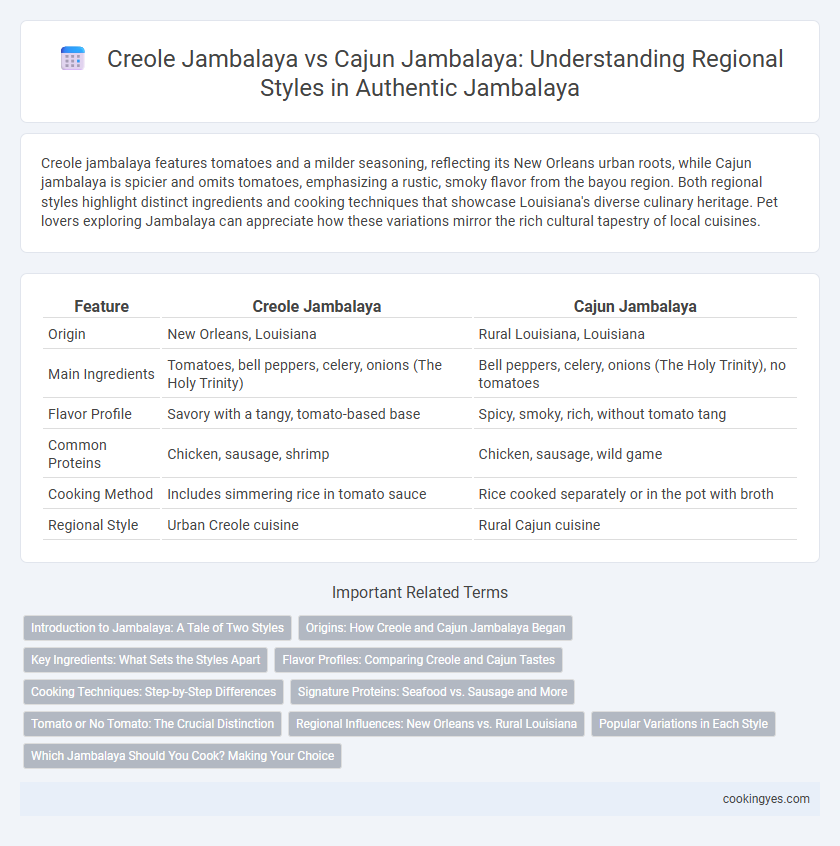Creole jambalaya features tomatoes and a milder seasoning, reflecting its New Orleans urban roots, while Cajun jambalaya is spicier and omits tomatoes, emphasizing a rustic, smoky flavor from the bayou region. Both regional styles highlight distinct ingredients and cooking techniques that showcase Louisiana's diverse culinary heritage. Pet lovers exploring Jambalaya can appreciate how these variations mirror the rich cultural tapestry of local cuisines.
Table of Comparison
| Feature | Creole Jambalaya | Cajun Jambalaya |
|---|---|---|
| Origin | New Orleans, Louisiana | Rural Louisiana, Louisiana |
| Main Ingredients | Tomatoes, bell peppers, celery, onions (The Holy Trinity) | Bell peppers, celery, onions (The Holy Trinity), no tomatoes |
| Flavor Profile | Savory with a tangy, tomato-based base | Spicy, smoky, rich, without tomato tang |
| Common Proteins | Chicken, sausage, shrimp | Chicken, sausage, wild game |
| Cooking Method | Includes simmering rice in tomato sauce | Rice cooked separately or in the pot with broth |
| Regional Style | Urban Creole cuisine | Rural Cajun cuisine |
Introduction to Jambalaya: A Tale of Two Styles
Creole Jambalaya hails from New Orleans and features tomatoes, creating a rich, tangy base, while Cajun Jambalaya from rural Louisiana relies on a roux and omits tomatoes, emphasizing smoky, savory flavors. The Creole style often includes a mix of seafood, sausage, and chicken, reflecting the city's diverse cultural influences, whereas Cajun Jambalaya is heartier with a focus on smoked meats like andouille sausage and local game. Both styles highlight the use of the "holy trinity" of onions, bell peppers, and celery, forming an essential flavor foundation.
Origins: How Creole and Cajun Jambalaya Began
Creole jambalaya originated in New Orleans, blending French, Spanish, and West African influences with tomatoes, reflecting its urban, diverse roots. Cajun jambalaya developed in rural Louisiana, featuring smoked sausage and a tomato-free base, highlighting the rustic, resourceful cooking of Acadian settlers. Both styles evolved from adapting available ingredients to create a hearty, flavorful rice dish central to Louisiana's cultural heritage.
Key Ingredients: What Sets the Styles Apart
Creole jambalaya features tomatoes, giving it a richer, saucier base, while Cajun jambalaya skips tomatoes, resulting in a drier, spicier dish. Key ingredients in Creole include bell peppers, celery, and onions, known as the "holy trinity," combined with chicken, sausage, and shrimp. Cajun jambalaya relies heavily on smoked sausage, such as Andouille, with a focus on bold spices and a hearty rice texture.
Flavor Profiles: Comparing Creole and Cajun Tastes
Creole jambalaya features a tomato-based sauce that adds a tangy sweetness and is often cooked with the "holy trinity" of onions, bell peppers, and celery, resulting in a rich, complex flavor profile. Cajun jambalaya, on the other hand, relies on a brown roux and omits tomatoes, creating a deeper, earthier taste with smoky undertones from the smoked meats used. Both styles emphasize bold spices, but Creole tends to be milder and more herbaceous, while Cajun is spicier and more robust.
Cooking Techniques: Step-by-Step Differences
Creole Jambalaya starts by sauteing onions, celery, and bell peppers before adding tomatoes, which creates a rich, saucy base, while Cajun Jambalaya begins with browning the meat and vegetables without tomatoes, resulting in a drier, smoky flavor. Creole style uses a simmering technique where rice absorbs the tomato-rich broth, contrasted with the Cajun method of cooking rice directly with meat juices for a deeper infusion of spice. These step-by-step cooking approaches highlight Creole jambalaya's tomato-infused, stew-like consistency versus Cajun jambalaya's hearty, browned, and rice-integrated texture.
Signature Proteins: Seafood vs. Sausage and More
Creole jambalaya typically features a tomato-based sauce and includes a variety of seafood such as shrimp and crab, reflecting its coastal New Orleans roots. Cajun jambalaya is known for its robust use of smoked sausage, such as Andouille, along with chicken and pork, emphasizing smoky and spicy flavors from Louisiana's inland regions. Both styles incorporate the "holy trinity" of onions, bell peppers, and celery, but their signature proteins highlight distinct regional culinary traditions.
Tomato or No Tomato: The Crucial Distinction
Creole jambalaya traditionally includes tomatoes, reflecting its urban New Orleans roots and French-Spanish influences, which contribute a rich, tangy base to the dish. Cajun jambalaya, originating from rural southwestern Louisiana, omits tomatoes, relying instead on browned meat and a dark roux to create a deep, savory flavor. This tomato or no-tomato distinction remains the crucial regional marker that defines the unique taste profiles of Creole and Cajun jambalaya.
Regional Influences: New Orleans vs. Rural Louisiana
Creole Jambalaya from New Orleans features tomatoes and reflects French, Spanish, and African culinary influences, showcasing the city's diverse cultural heritage. Cajun Jambalaya, originating in rural Louisiana, excludes tomatoes and emphasizes smoky, rustic flavors derived from local game and sausage. The regional distinction highlights New Orleans' urban fusion versus Cajun country's resourceful, countryside cooking traditions.
Popular Variations in Each Style
Creole Jambalaya typically features tomatoes, a hallmark of New Orleans cuisine, alongside a mix of bell peppers, onions, celery, and a blend of pork, sausage, and seafood like shrimp. Cajun Jambalaya, originating from rural Louisiana, emphasizes a tomato-free, smoky flavor profile with a heavier use of spices and ingredients such as smoked sausage, chicken, and the "holy trinity" of vegetables. Both styles showcase regional variations that highlight distinct seasoning techniques and ingredient combinations, reflecting the cultural influences of their respective Louisiana regions.
Which Jambalaya Should You Cook? Making Your Choice
Creole Jambalaya features tomatoes and a mix of vegetables like bell peppers, celery, and onions, reflecting its New Orleans origin, while Cajun Jambalaya relies on a smoky, roux-based base with no tomatoes, typical of rural Louisiana. Choosing which jambalaya to cook depends on your preference for either the tangy, vibrant Creole style or the rich, earthy Cajun flavor profile. Regional authenticity influences ingredients and cooking methods, making Creole jambalaya lighter and Cajun jambalaya heartier and spicier.
Creole Jambalaya vs Cajun Jambalaya for regional style Infographic

 cookingyes.com
cookingyes.com